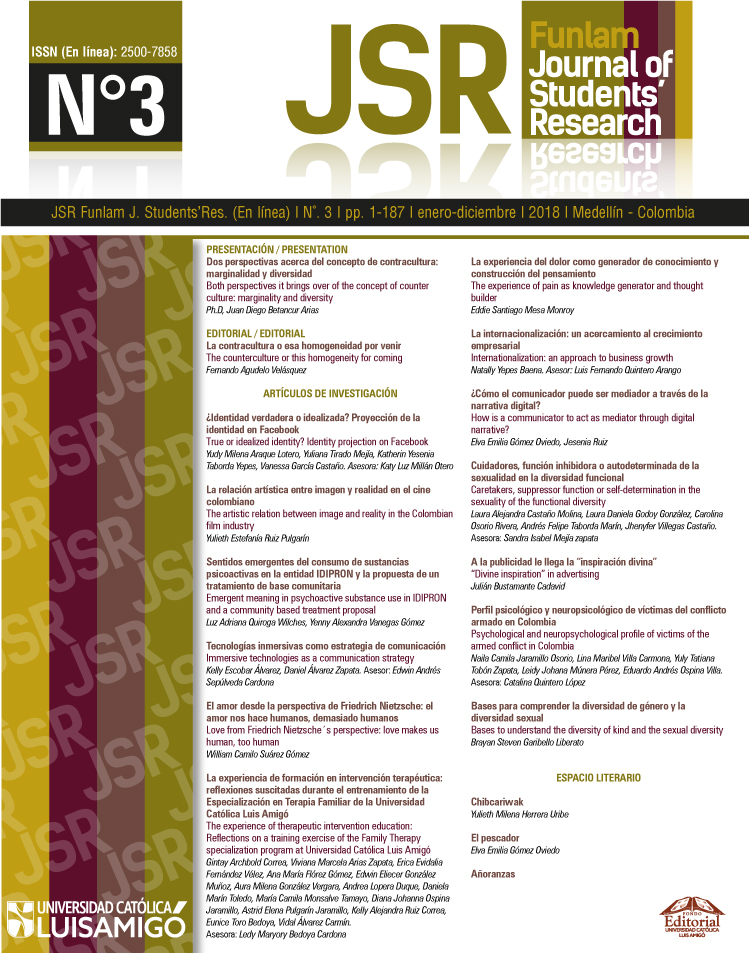Sentidos emergentes del consumo de sustancias psicoactivas en la entidad IDIPRON y la propuesta de un tratamiento de base comunitaria
DOI:
https://doi.org/10.21501/25007858.3130Palabras clave:
Drogodependencia, Factores protectores, Factores de riesgo, Prevención primaria, Prevención secundaria, Prevención terciaria, Tratamiento de Base Comunitaria.Resumen
Este artículo revisa el consumo de sustancias psicoactivas (SPA) como categoría inicial de análisis en 5 jóvenes entre 25 y 27 años, adscritos a la Unidad de Protección Integral “La Rioja” del Instituto Distrital para la Protección de la Niñez y la Juventud IDIPRON en Bogotá, a quienes se les realizó una entrevista semiestructurada, encontrando en sus respuestas algunos sentidos emergentes como la negligencia en la supervisión, proyecto de vida deficiente, vínculos afectivos débiles, pares negativos y reconocimiento de su consumo. Estos sentidos emergentes permitieron concluir categorías que explican el origen del consumo de SPA y la situación actual de estos jóvenes, como los tipos de crianza, los estados de identidad, los vínculos familiares y las etapas de cambio en las adicciones. Se concluye que, realizando una adecuada identificación de los factores de riesgo que se evidencian en los sentidos emergentes de un grupo, se puede plantear un tratamiento basado en la comunidad (CBT, por sus siglas en inglés), con evidencia científica, que se ajuste a las condiciones particulares y al contexto real modificando patrones de conducta claramente determinantes en la drogodependencia de cada joven.Descargas
Referencias
Becoña Iglesias, E. (2002). Bases científicas de la prevención de las drogodependencias. Madrid: Plan Nacional sobre Drogas.
Becoña Iglesias, E. (2007). Bases psicológicas de la prevención del consumo de drogas. Papeles del Psicólogo,28(1), 11-20. Recuperado de http://www.redalyc.org/pdf/778/77828103.pdf
Bordignon, N. A. (2005). El desarrollo psicosocial de Eric Erikson. El diagrama epigenético del adulto. Revista Lasallista de Investigación, 2(2), 50-63. Recuperado dehttp://www.redalyc.org/pdf/695/69520210.pdf
Clayton, R. R. (1992). Transitions in drug use: Risk and protective factors. In M. Glantz & R. Pickens (Eds.),Vulnerability to drug abuse (pp. 15-51). Washington, C.D: American Psychological Association. DOI:http://dx.doi.org/10.1037/10107-001
Milanese, E. (2012). Tratamento comunitário: manual de trabalho I. São Paulo: Secretaria Nacional de Políticasde Drogas, Instituto Empodera.
Millman, R. B., & Botvin, G. J. (1992). Substance use, abuse, and dependence. In M. Levine, N.B. Carey, A. C. Crocker y R. T. Gross (Eds.), Developmental–Behavioral Pediatric (pp. 451-467) (2a. ed.). Nueva Cork: Saunders.
Ministerio de la Protección Social, MSPS. (2007). Política nacional para la reducción de consumo de sustancias psicoactivas y su impacto. Bogotá: Ministerio de la Protección Social.
Ministerio de Salud y Protección social, MSPS. (2012). Caja de herramientas, tratamiento basado en la comunidad. Bogotá: Peñafiel.
Papalia, D., Wendkos Olds, S., y Duskin Feldman, R. (2012). Desarrollo Humano. México: Mc Graw Hill.
Pesca, A. (2016). IDIPRON: Una experiencia pedagógica de la calle. Recuperado de http://www.idep.edu.co/sites/default/files/libros/Una%20experienci%20de%20convivencia%20social.pdf
Prochaska, J., & DiClemente, C. (1984). The transtheoretical approach. New York: Dow Jones.
Valles, M. (2002). Cuadernos metodológicos. Entrevistas cualitativas. España: Centro de Investigaciones Sociológicas.


